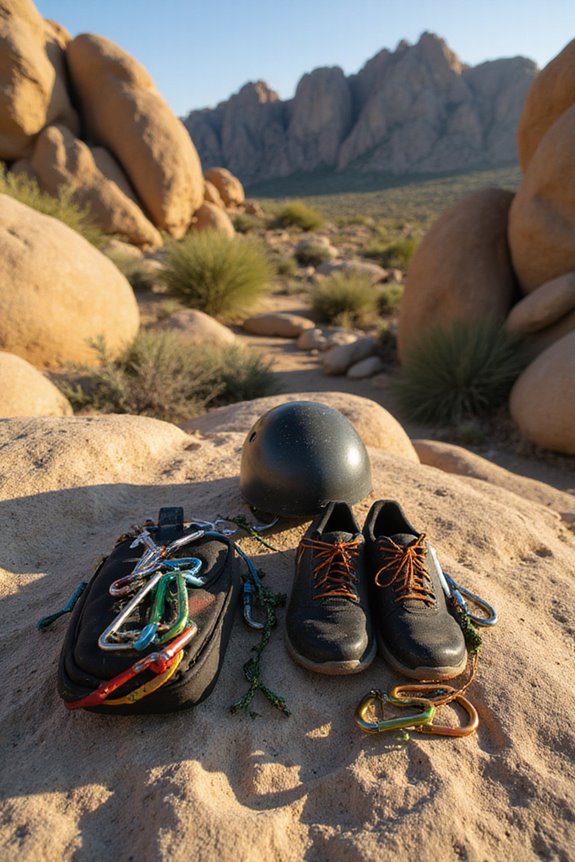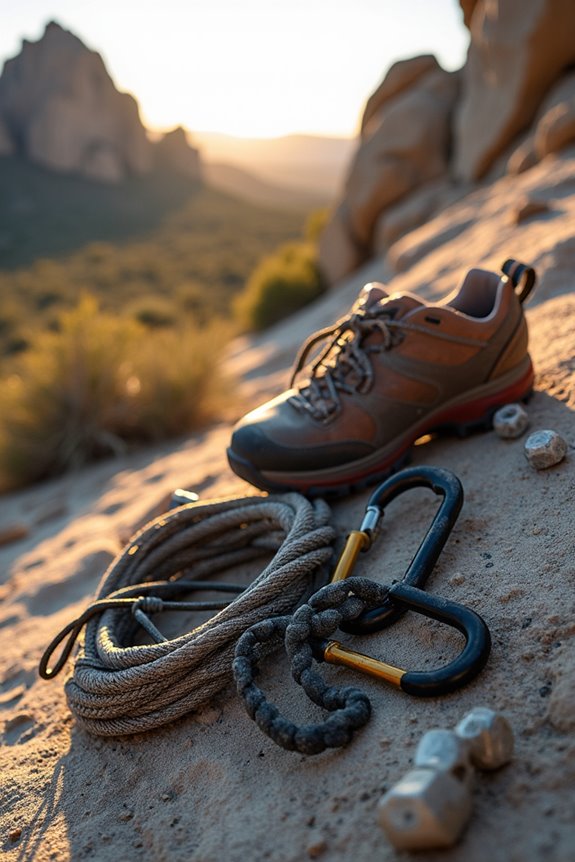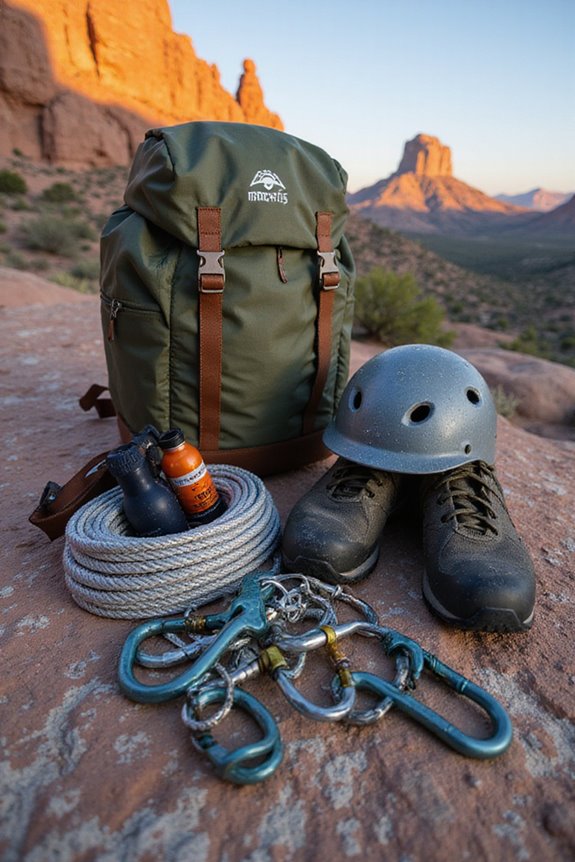When we hit the rocks, we need to pack smart! First, grab climbing shoes and a reliable harness—your safety lifeline. Don’t forget chalk for sweaty palms and a sturdy helmet for that unplanned rock rain. Hydration’s key, so bring your CamelBak and some energy-packed snacks. Toss in a first aid kit, quickdraws, and a belay device for safety. And like they say, a well-filled pack makes for happy climbing. Let’s gear up, and I’ll share more must-haves!
Key Takeaways
- Pack climbing shoes for optimal grip and comfort on rock faces, along with a trusty harness for safety during climbs.
- Don’t forget a helmet for head protection and a chalk bag to keep hands dry for better grip.
- Bring essential climbing tools including a rope, quickdraws, and a belay device for safe ascents and descents.
- Include proper clothing like moisture-wicking layers and a waterproof jacket to adapt to changing weather conditions.
- Ensure hydration with water bottles or packs, and carry calorie-dense snacks for sustained energy during climbs.
Essential Climbing Gear
When it comes to rock climbing, having the right gear can make all the difference between an epic adventure and a total meltdown—trust me, we’ve all been there! First off, let’s talk about essential climbing gear. We can’t underestimate the power of climbing shoes; they’ll give us that sweet precision we crave on the rock face. Approach shoes? A lifesaver for those hikes to the crag. And don’t forget a trusty harness, as it’s our lifeline up there. Chalk bags keep our hands dry for maximum grip, while gloves protect our hands during those sketchy moments. A compact first aid kit with waterproof construction is essential for addressing minor injuries that might occur during your climbing adventure. Remember: every item matters. Pack wisely, and we’ll be ready to embrace the freedom of the climb without worrying about our gear. Let’s get climbing!
Protection and Safety Equipment
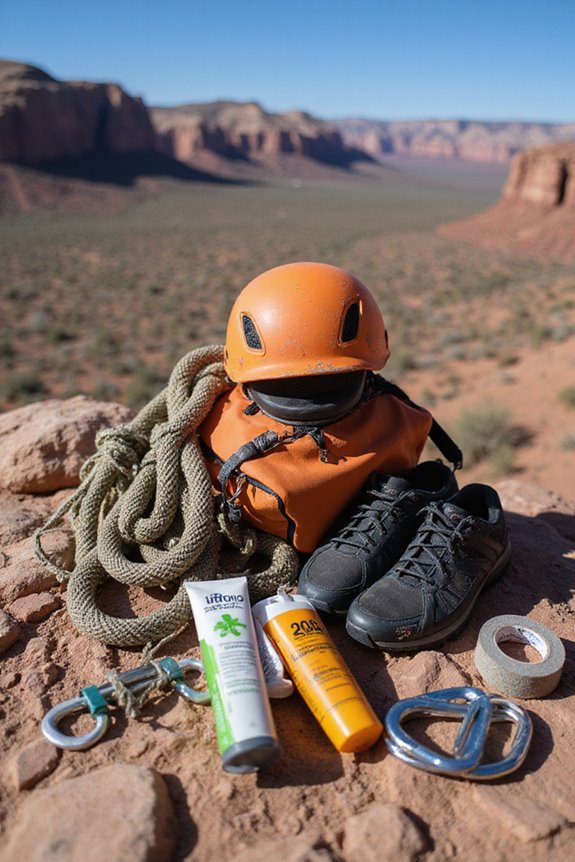
While we crave the thrill of summit views and the rush of a tough climb, we can’t forget about protection and safety equipment. First, let’s harness the power of active protection like spring-loaded cams or Big Bros for those wider cracks—they really save our skin! On the flip side, passive protection like nuts and hexes keep us secure in those gnarly placements.
Next, don’t skimp on supplemental safety gear—carabiners, slings, and, of course, a reliable belay device are essential for managing falls. Consider carrying a personal locator beacon for emergency situations when climbing in remote areas. Crash pads are your best friend in bouldering! And hey, bring along some duct tape for emergency repairs—it’s a climber’s magic wand. So, gear up and let’s conquer those rocks, feeling wild and free!
Anchor and Anchoring Supplies
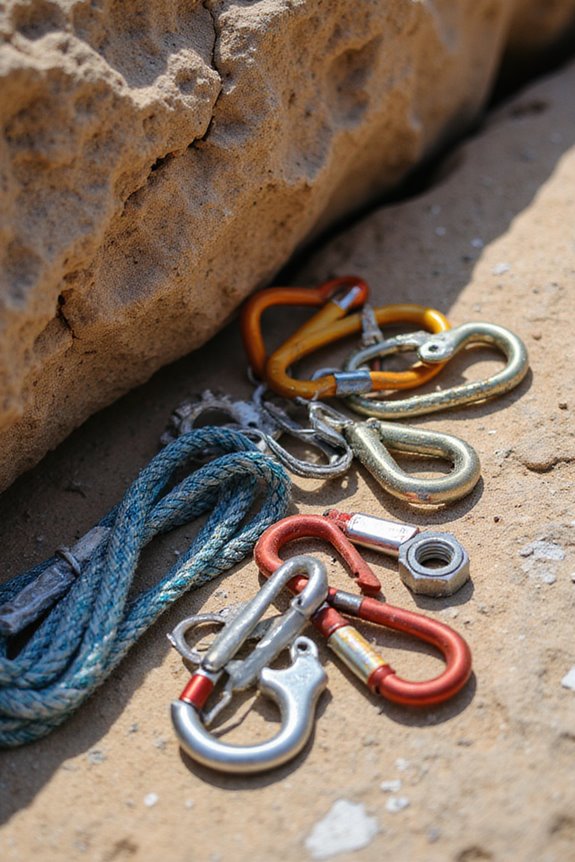
As we enjoy the exhilarating heights of rock climbing, we can’t overlook the importance of solid anchors and anchoring supplies. Whether we’re eyeing those towering cliffs or craggy outcrops, we need tough anchor types that keep us secure. A basic top-rope anchor kit—featuring a 120cm or 180cm sling, a triple-action HMS carabiner, and two non-locking D carabiners—does wonders!
For more security, why not opt for screwgate carabiners? They really cut down the risk of surprises. And let’s not forget about the static lines; they’re super adaptable and strong, perfect for connecting anchor points. Similar to how reliable locking mechanisms prevent unexpected collapses during hikes with trekking poles, proper carabiners ensure your anchors won’t fail during a climb. With quality anchor materials, we can truly embrace the freedom of the climb while staying safe and sound. Adventure awaits!
Clothing and Approach Gear
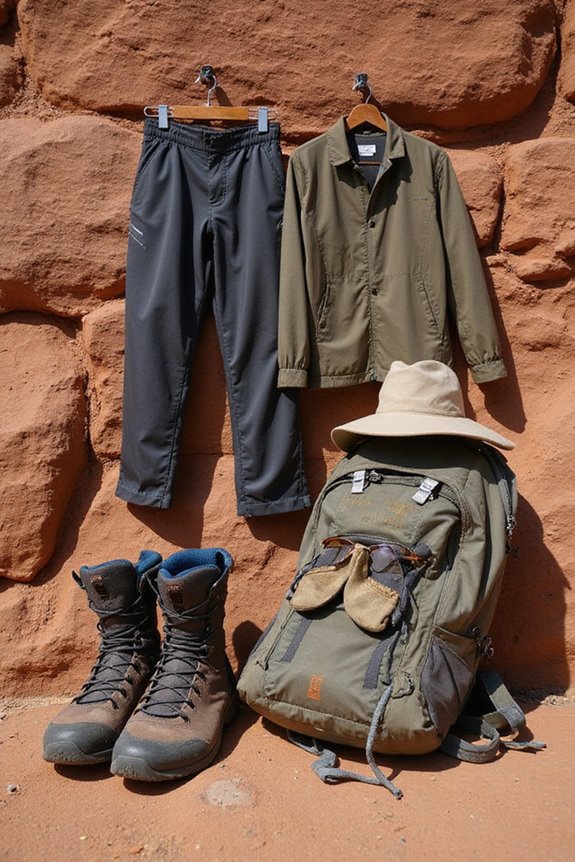
Gear up, adventurers! When it comes to clothing and approach gear for rock climbing, we want to guarantee we’re ready for anything. Using clever layering techniques is key, so we can adapt to changing weather. Start with breathable long sleeves and full-length pants made from durable, flexible fabrics—trust us, those pesky scrapes are no joke! Say goodbye to cotton, as it’ll leave you cold and soggy; synthetic fabrics are where it’s at!
When we hit the trail, comfy approach shoes with sticky soles are essential for good traction. Don’t forget a lightweight, waterproof jacket for surprise downpours. Look for footwear with multi-directional lugs to enhance stability during technical approaches and descents. With the right gear, we can embrace our love for the outdoors and tackle those climbs head-on! Let’s go conquer some rocks!
Hydration and Nutrition
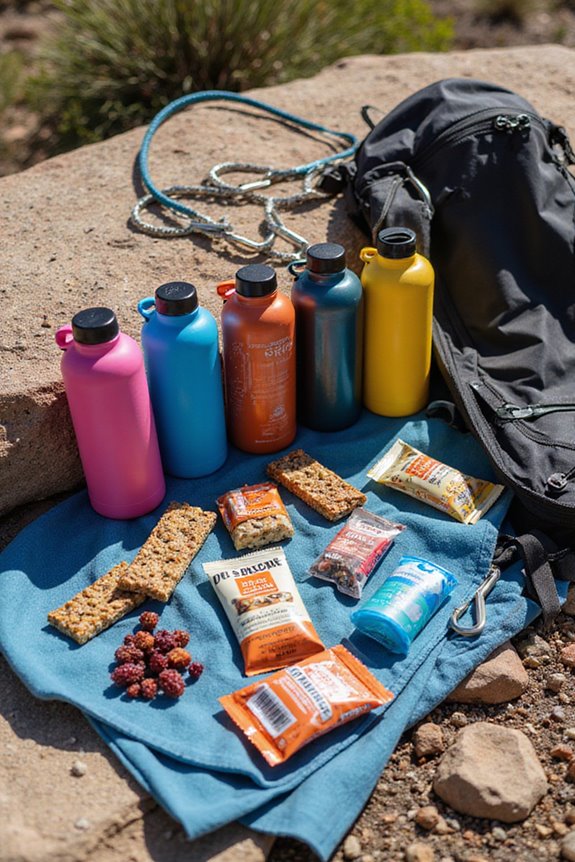
When we’re out on the rocks, hydration and nutrition can’t be an afterthought—they’re as essential as our climbing gear! We all know those thrilling moments of reaching the summit, but without proper hydration techniques, we risk losing our edge before we even start. Remember to monitor our water intake and sip regularly. We can use compact hydration packs with easy-access tubes to keep the flow going. Consider bringing a CamelBak Podium Chill that provides double-wall insulation to keep water cold for extended periods during hot climbing days. For nutrition timing, let’s pack calorie-dense snacks like nuts and energy bars to fuel our climbs. And don’t forget those simple carbs for quick energy boosts—they’re lifesavers! Keeping our bodies fueled keeps our spirits high, so we can embrace every breathtaking moment on this awesome adventure. Let’s climb on!
Miscellaneous Items
Packing for a climbing adventure isn’t just about the big stuff—we need to think of those miscellaneous items that can make or break our day on the rock. We can’t forget climbing tape for those pesky finger injuries and a trusty multi-tool for any gear maintenance emergencies. Sunglasses with a retention strap? Absolutely essential to keep our vision clear and our gear intact!
A hat for sun protection or warmth is a must, especially when climbing etiquette might mean we’re stuck waiting in the sun. Let’s also stash a cell phone in a waterproof bag, just in case we need to make that emergency call. Finally, a bag for collecting trash helps us leave the environment as beautiful as we found it!
Packing and Organization Tips
Ready to tackle your next climbing adventure? We’ve got some great packing strategies to make certain you’re ready for anything nature throws our way! First off, gear prioritization is key—pack essentials like moisture-wicking layers and a lightweight rain jacket right at the top for easy access. We love using packing cubes to separate climbing gear from snacks—nobody wants to dig through a stuffed bag for that granola bar!
Let’s not forget about organization; keeping our ropes in bags prevents tangling, and a quick check of our equipment checklist makes certain safety items aren’t left behind. Remember, balance our pack weight for comfort—it makes those approach hikes feel a little less intimidating. Happy climbing, everyone, and let’s keep the adventure flowing!
Climbing Shoes and Harness
Choosing the right climbing shoes and harness is like finding the perfect partner for your climbing adventures—they should fit snugly, support us, and make every ascent feel exhilarating! We want shoes that feel like a glove, enjoying that buttery grip on the rock. Look for shoe fit that enhances precision on those tricky footholds, and don’t forget about the closure systems! Velcro is fantastic for quick escapes, while laces let us fine-tune our fit.
Now, let’s talk harness types! Lightweight sport harnesses are great for quick climbs, while trad harnesses offer extra gear loops and padding for those epic, long hangs. Finding the right combo of comfort and functionality can truly elevate our climbing experiences. Ready to take on the wall? Let’s go!
Route Navigation Tools
When venturing into the wild on a climbing adventure, we can’t underestimate the importance of route navigation tools—they’re our trusty companions! First off, bringing topographical maps and updated guidebooks keeps us dialed into the terrain. Digital maps are great, but let’s not forget backup power; phones love dying at the worst times!
GPS devices and apps are lifesavers, especially with offline maps. But how about a trusty compass? It never runs out of battery and loves to keep us grounded!
Marking trails with flagging tape and using colored chalk can ease confusion in tricky spots. Remember, freedom in the wild comes with responsibility—let’s keep our tools handy, our routes clear, and adventure in our hearts!
Frequently Asked Questions
What Type of Climbing Is Best for Beginners?
When we’re starting our climbing journey, indoor climbing’s great for building skills safely, while outdoor climbing offers adventure. Let’s embrace both, enjoying strength progression and the thrill of nature as we grow together.
How Do I Choose the Right Climbing Route?
Just as a painter selects their canvas, we should carefully choose our climbing route, matching route difficulty to our skills and preferred climbing style. This guarantees that our adventurous spirits soar while staying safe.
What Are the Risks of Climbing Without Gear?
When we consider the risks of climbing without gear, gear failure and injury prevention become vital. The thrill of freedom isn’t worth the severe injuries or dangers; safety measures guarantee we enjoy climbing with fewer worries.
When Is the Best Season for Rock Climbing?
Isn’t it exhilarating to think about climbing under perfect spring conditions? We find that avoiding the summer heat lets us enjoy our ascents, ensuring both safety and joy while we embrace the freedom of the outdoors!
Can I Climb Alone or Should I Always Have a Partner?
While solo climbing can offer a sense of freedom, we must prioritize safety precautions. Climbing with a partner enhances our experience, ensuring we’re supported, reducing risks, and allowing us to focus on the climb’s joy together.

